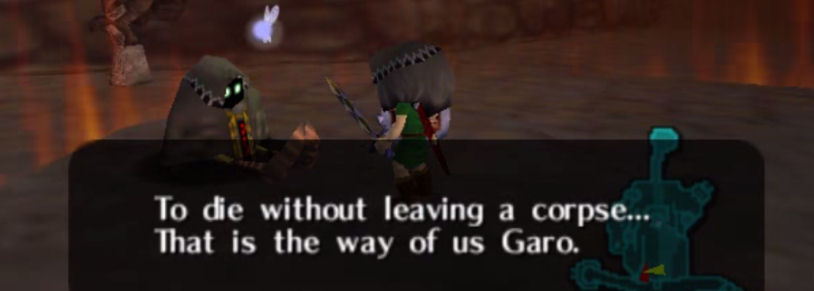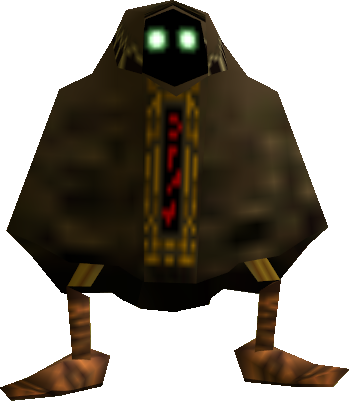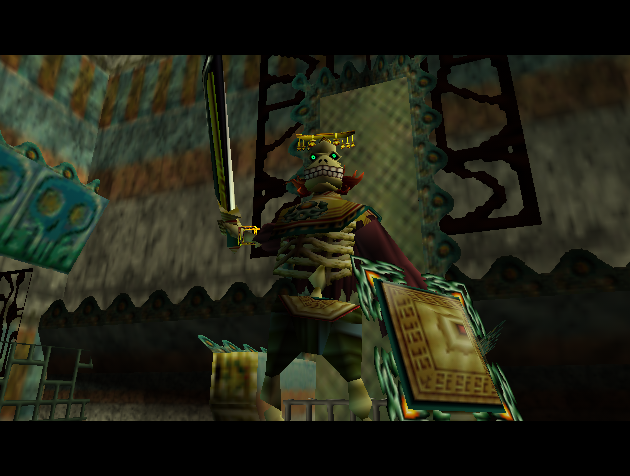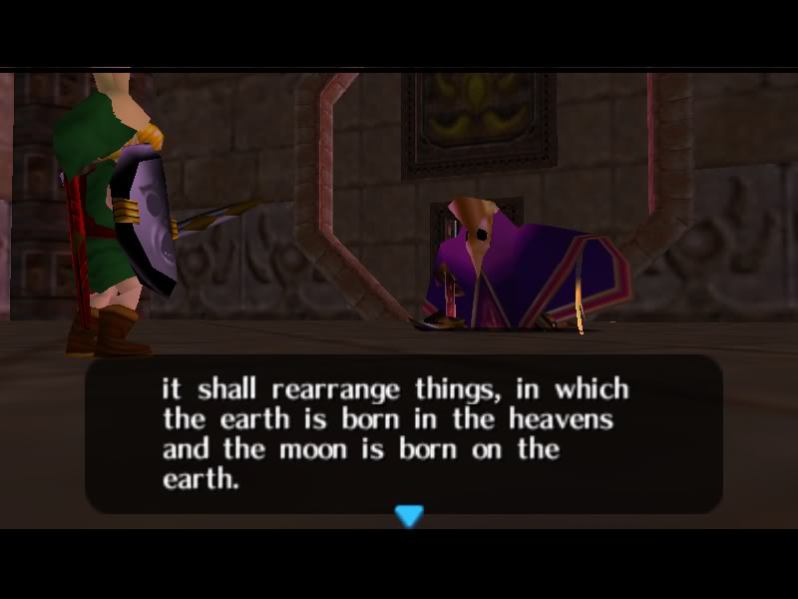“Majora’s Mask” Addresses Marginalized Groups in a Way you Might Miss — and That’s the Point.
Posted on January 10 2015 by Aaron Suduiko

“Majora’s Mask” is rated “E for Everyone” by the ESRB, which recommends the game as suitable to people of all ages. Yet the more I review the game, the more I am awed by the level of very thinly veiled adultness in virtually every aspect of its content. It was not until recently, for instance, that I realized the game contains a thesis on how groups are marginalized by society. In this post, I argue that the ease with which one can miss this game element is precisely what makes its content so impactful.
The fourth and final corner of the world of Termina that Link must traverse is the desolate Ikana Canyon, home to the kingdom of the Ikana, a warrior clan of skeleton-like creatures. I will return to the Ikana later, but I presently want to focus on the creatures not meant to be in the canyon: a race of once-ninjas, now ghosts, called the Garo.
Pamela’s father, a scientific surveyor of paranormal phenomena in Ikana Canyon, describes the Garo as “merely shells that are empty on the inside. They’re the shells of spies from an enemy nation sent to investigate Ikana. They have been unable to forget their living days. Even now their spirits–emptiness cloaked in darkness–continue to spy… [They] are still ninja and they will not show themselves in front of people.” The Garo are intriguing for a variety of reasons. They do not appear within Zelda canon outside of “Majora,” making them one of the ontological elements peculiar to Termina; their history is only ever vaguely described as the would-be invaders of Ikana in a long-forgotten Garo-Ikana war that was resolved long before Link arrived in Termina; they cling to life in spite of being dead, manifesting as what Buddhists would call ‘hungry ghosts.’ Yet there is a more insidious and provocative side to the discourse on Garo, which only becomes apparent when we consider their persistent relationship with the Ikana.
“Majora” is rated E for Everyone, and there is a story of the Garo that a child can easily take at face value. The Garo are ninja ghosts, who posses a strict code of honor. As spies, they are extremely knowledgeable about Ikana Canyon, and are therefore valuable assets to Link in exploring the region. In order to draw them out, Link must wear the Garo Mask to disguise himself as a Garo leader; Garo then appear, thinking that their Master has arrived, and, upon realizing that Link is an imposter, confront him in a duel. When Link defeats the Garo, they compliment his fighting skills and respond by offering their knowledge; they then commit ritual suicide, saying “To die without leaving a corpse… That is the way of us Garo.” By defeating Garo in this way, Link is able to progress through the canyon, eventually meeting the king of the Ikana and gaining access to the Stone Tower Temple, where the fourth Giant is sealed; the only other encounter Link has with Garo in the game is within the temple, where he must defeat a Garo Master who serves as a miniboss within the Temple.
Yet if we have seen anything about the world of “Majora” by now, it is that we ought to question the face-value explanations offered by the game. It is in that spirit that I offer an alternative reading of the Garo. To set the stage, we need more background on the Ikana who occupy Ikana Canyon. A warrior race, the game makes it clear that they dominate the region: Link must defeat an enormous Ikana captain, Skull Keeta, in order to gain access to the canyon; he must then confront and defeat the king of the Ikana, Igos du Ikana, in order to access the Stone Tower Temple. The centerpiece of the canyon, too, is the castle of the Ikana kingdom, in which the king resides.
When Link encounters Igos du Ikana and his bodyguards, they are corrupted by “true darkness,” until Link liberates their spirits with light by slaying them. So the image of the Ikana is that of a monarchy corrupted by absolute darkness in a postbellum, apocalyptic context. Return now to the Garo: they never actually refer to themselves as spies, or as ninjas; rather, we are led to ascribe this story to them based on what third-parties, such as Pamela’s father, say about them. So it is perfectly reasonable why children would accept the face-value story. However, if we consider the Garo independently of the ascribed ninja/spy identity, a much less comfortable image emerges: the Garo is a literally an invisible race, metaphysically subordinated as ghosts, and socio-politically subordinated as outsiders and enemies of Ikana, the ruling class of true darkness. Their identities are masked in formless robes, and they appear in the game only in the context of being slain.
Of course, Link is able to free the Ikana from the corrupt forces of darkness and provide them with clarity, but this only makes the account of the Garo more problematic. In order to reach Igos du Ikana and cleanse him of darkness, Link must mow down countless Garo to obtain the information they possess. What’s more, he draws the Garo out of their secure invisibility by posing as their “Master” — a phraseology which invites one to think of Link in this moment as a false savior, one who deceives with a mask in order to use a people as a means to an end.
At this juncture, a utilitarian might reply that Link is justified in using the Garo as a means to an end, because the end is the prevention of the universe’s demise. Yet the picture is more complicated than this. When I discussed the sidequests of “Majora,” I concluded that Link could save everyone in Termina even though he could not save them all in a single discrete timeline; but this thesis now needs refining, because Garo cannot be saved in any timeline; rather, they must be killed in order to advance the story.
At the heart of the emerging issue is the fact that Garo are classed within the game as ‘monsters.’ To be precise, I use ‘monsters’ to refer to non-player creatures or characters within a video game, which are hostile towards the player, capable of killing the player, and capable of being killed by the player. Monsters are a hero’s enemies within the game, obstacles to the ultimate goal of the game. Taken with the fact that many monsters have little-to-no backstory or narratological context, this explains why it typically does not make sense to talk of “saving monsters” within the medium of video games.
I propose that this is precisely the issue that “Majora” is prompting the player to grapple with: ought we to conceive of the Garo as monsters? The only suggestions of their malice are exogenous of the actual facts of their condition; taken in a vacuum, the Garo are subjugated, unseen spoils of a war that only exists in anecdotal recollection. If Link did not hunt them, it is not at all apparent that they would ever show themselves or interfere in the events of Termina. In fact, it seems that the Garo only have agency because Link goes out of his way to see them — and Link only goes out of his way to see them in order to assault them. If this were another “Zelda” game, the presence of Zelda might as least tacitly provide a moral explanation for Link’s action; yet I have already argued that the lack of Zelda in Termina strips Link of any moral compass.
What can we glean from this disturbing aspect of Link’s journey? I propose that there are three major takeaways worth considering.
1. With childlike innocence comes childlike ignorance. Link, like the youngest players of “Majora,” is a child; he is not in a position to articulately question the norms that are presented to him by the people in authority whom he meets on his journey (in point of fact, he cannot question them at all, by virtue of being a silent protagonist). When I previously touched on Link’s innocence, it was in the positive light of mitigating the moral affect associated with death; yet other people in Termina are adults who do have judgmental preconceptions, and so it becomes apparent that Link’s innocence also leaves him malleable, and ignorant in a way that allows him to conceive of Garo as ‘spy’ and ‘enemy’ independently from any firsthand evidence.
2. Game mechanics can be significantly unreliable in the same way that a narrator can be unreliable. The adult player of “Majora” is in a position to observe, as we have, that there is a significant dissonance between the actual observed state of the Garo and the game’s description of them as enemies. This is a prime example of narratological nuance emerging from video games: just as we enter a novel trusting the veracity of its narrator, so too do we enter a video game trusting that the game mechanics will direct us towards the ultimate goal of the game and proper resolution of the plot. Yet tension can arise in a narrative that leads us to believe a narrator is unreliable; likewise, in this sequence of “Majora,” we are lead to doubt the reliability of the game mechanics, which demand we slay Garo even as the game’s universe suggests that their deaths are unjustified. Though I did not say so with the same words while discussing the Fierce Deity, this same idea is at play with the Fierce Deity’s Mask: it is in the moment of donning the final mask and realizing the nihilistic metaethical thesis that we are left to doubt the entire narratological framework of the quest to “save” Termina. When the credits roll, everyone whom Link could save is shown as having been saved; yet we know that it is impossible to save everyone in one timeline. So the narrative dissonance seems in some significant sense to be global. Vetting the implications of this is a topic for another time; one initial proposal for explaining it is that a metaethically nihilistic world tends to generate the perception of dissonance and contradiction in the player when the player believes in objective moral truth, because they are seeking to analyze the game’s universe through a framework that ultimately does not obtain in that universe.
3. The marginalization of social groups is (at least in part) effected and maintained by the conditioning of the uninformed by prejudiced peoples, such that the uninformed perceive marginalized social groups through inherently prejudiced paradigms without realizing it. It is this ontological thesis of marginalization which most surprised me, simply because I have always thought of “Zelda” as a series that celebrates the cooperation of various tribes, races, and cultures (Zoras, Gorons, Hylians, &co). Yet upon reflection, I think it is precisely because of this background of supposed-diversity in the “Zelda” canon — particularly in “Ocarina of Time” — that “Majora” was uniquely poised to throw the perception of diversity into question. For at the same time that the “Zelda” canon unites diverse tribes, it also possesses (outside of “Majora”) a strict conception of good and evil (this is a generalization, but I think it is a fair gloss of the typical canon in comparison to “Majora”). “Majora” then discards morality and asks if we can still justify the claim that Link’s domain is inclusive and accepting of different walks of life. The answer, the Garo suggest, is a resounding “no.”
The Garo are invisible outsiders, judged to be spies and enemies based on ancient history and hearsay; and when Link, their false savior, defeats them, they die without leaving a corpse, never to be remembered, mourned, or known — a direct contrast to the ruling Ikana, who have their own graveyard where heroes and commoners alike are remembered and honored. Link the Child, the Zelda-less, and the Stranger is in no position to question this social structure; rather, the predisposition of other people, taken to be more knowledgeable, directly creates his paradigm of assigning meaning to the Garo. The Garo become fodder as a means to an end because they were believed to be so. If Link had met a Garo before learning of them from other sources, he may not have conceived of them of enemies; yet the fact that society had already made them invisible precludes this possibility from ever becoming reality.
I do not think that “Majora” means to leave us devoid of hope. When Link defeats the Garo Master in the Stone Tower Temple, the Garo shares with him his knowledge pertaining to the structure of the temple: by shooting a Light Arrow at a specific place outside the Temple, Link can literally turn the Temple upside-down, which is necessary to reach the boss and liberate the fourth Giant. Notice the language used by the Garo Master: a Light Arrow fired in this way, he says, “shall rearrange things, in which the earth is born in the heavens and the moon is born on the earth.” That which is conceived as the ‘natural order’ — heaven, earth, and moon — can be subverted and rearranged by Link’s agency. In the case where the natural is transformed into the deformed, viz. Skull Kid bringing down the moon, it is Link who can put the moon back in the heavens; in the case where the deformed is masquerading as the natural, viz. the social order in Ikana Canyon, it is Link the Child, malleable but also innocent and yet to mature, who has the potential to expose and change the fundamental paradigm that others see as inevitable. That the Garo must die does not mean it must be their way to leave no corpse.
Want to follow the analysis and theory? Read on at With a Terrible Fate.
Aaron Suduiko, Phillips Exeter Academy ’13, Harvard University ’17. Studies philosophy with a focus on developing new aesthetic theory with a grounding in the medium of video games. In 2013, he conducted a comparative analysis of role playing paradigms in video games (“Legend of Zelda: Majora’s Mask,” “Nier,” “Dishonored,” and “Deus Ex: Human Revolution”) and plays (“Six Characters in Search of an Author,” “The Man in the Iron Mask,” “Macbeth,” and “Flowers for Algernon.” He is the author of “With a Terrible Fate,”a twice-weekly analysis of “Majora’s Mask” that is published by Zelda Dungeon and is set to continue through the release of the 3D remake this coming spring. Suduiko is reachable at withaterriblefate@gmail.com.







